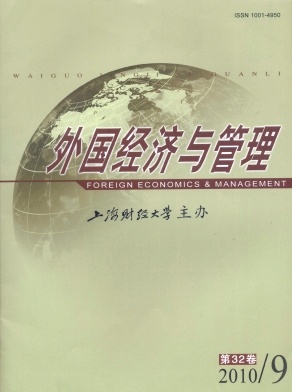基于制度基础观的企业区域多元化进入模式研究述评
外国经济与管理 2010 年 第 32 卷第 09 期, 页码:23 - 29
摘要
参考文献
摘要
战略管理研究在经历了基于产业基础观和资源基础观的研究热之后,又迎来了基于制度基础观的研究热潮。本文先对有关企业区域多元化进入模式的已有研究文献进行了回顾,然后立足于战略管理研究的制度基础观视角,重点对企业区域多元化进入模式的制度影响因素研究现状进行了述评,并对我国企业地域多元化进入模式的未来研究进行了简要展望,以供后续相关研究参考。
[1]张永宏.组织社会学的新制度主义学派[M].上海:上海人民出版社,2007.
[2]Suchman,M.Managing legiti macy:Strategic and institutional approaches[J].Academy of Management Review,1995,20(3):571-610.
[3]Meyer,John W,and Brian Rowan.Institutionalized organizations:Formal structure as myth and ceremony[J].American Journalof Sociology,1977,83(2):340-363.
[4]Di Maggio,Paul J,and Walter WPowell.The iron cage revisited:Institutional isomorphismand collective rationalityin organiza-tional fields[J].American Sociological Review,1983,48(2):147-160.
[5]Chan,C M,and Makino,S.Legiti macy and multi-level institutional environments:I mplications for foreign subsidiary ownershipstructure[J].Journal of International Business Studies,2007,38(4):621-639.
[6]Grewal,Rajdeep,and Ravi Dharwadkar.The role of the institutional environment in marketing channels[J].Journal of Marketing,2002,66(3):82-97.
[7]Ma,Xufei,and Andrew Delios.Foreign direct invest ment in East Asia’s transitional economies:Perspectives on development andtransition-Anewtale of two cities:Japanese FDIsin Shanghai and Beijing,1979-2003[J].International Business Review,2007,16(2):207-228.
[8]Hoskisson,Robert,Eden,E,Lorraine,Chung,Ming,Lau,and Mike Wright.Strategy in emerging economies[J].Academy of Mana-gement Journal,2000,43(3):249-267.
[9]Yiu,Daphne,and Shige Makino.The choice between joint venture and wholly owned subsidiary:An institutional perspective[J].Organization Science,2002,13(6):667-683.
[10]Lenway,Stefanie Ann,and Thomas P Murtha.The state as strategist in international business research[J].Journal of Interna-tional Business Studies,1994,25(3):513-535.
[11]Kostova,Tatiana,and Srilata Zaheer.Organizational legiti macy under conditions of complexity:The case of the multinational en-terprise[J].Academy of Management Review,1999,24(1):64-81.
[12]Kogut,Bruce,and Harbir Singh.The effects of national culture onthe choice of entry-mode[J].Journal of International BusinessStudies,1988,19(3):411-432.
[13]Agarwal,S.Socio-cultural distance andthe choice of joint ventures:Acontingency perspective[J].Marketing,1994,2(2):63-80.
[14]Gripsrud,Geir,Gabriel,R,and G Benito.Internationalizationin retailing:Modelingthe pattern of foreign market entry[J].Jour-nal of Business Research,2005,58(12):1 672-1 680.
[15]Oliver,C.Strategic responses to institutional processes[J].Academy of Management Review,1991,16(1):145-179.
[16]Padmanabhan,Prasa,and Kang Rae Cho.Decision-specific experience in foreign ownership and establishment strategies:Evi-dence fromJapan[J].Journal of International Business Studies,1999,30(1):25-43.
[17]Amburgey,T L,and AS Miner.Strategic momentum:The effects of repetitive,positional,and contextual momentumon mergeractivity[J].Strategic Management Journal,1992,13(5):335-348.
[18]Li,J,Yang,J Y,and D R Yue.Identify,community,and audience:How wholly ownedforeign subsidiaries gainlegiti macyin China[J].Academy of Management Journal,2007,50(1):175-190.
[19]Haunschild,P R,and A S Miner.Modes of inter-organizational i mitation:The effects of outcome salience and uncertainty[J].Administrative Science Quarterly,1997,42(3):472-499.
[2]Suchman,M.Managing legiti macy:Strategic and institutional approaches[J].Academy of Management Review,1995,20(3):571-610.
[3]Meyer,John W,and Brian Rowan.Institutionalized organizations:Formal structure as myth and ceremony[J].American Journalof Sociology,1977,83(2):340-363.
[4]Di Maggio,Paul J,and Walter WPowell.The iron cage revisited:Institutional isomorphismand collective rationalityin organiza-tional fields[J].American Sociological Review,1983,48(2):147-160.
[5]Chan,C M,and Makino,S.Legiti macy and multi-level institutional environments:I mplications for foreign subsidiary ownershipstructure[J].Journal of International Business Studies,2007,38(4):621-639.
[6]Grewal,Rajdeep,and Ravi Dharwadkar.The role of the institutional environment in marketing channels[J].Journal of Marketing,2002,66(3):82-97.
[7]Ma,Xufei,and Andrew Delios.Foreign direct invest ment in East Asia’s transitional economies:Perspectives on development andtransition-Anewtale of two cities:Japanese FDIsin Shanghai and Beijing,1979-2003[J].International Business Review,2007,16(2):207-228.
[8]Hoskisson,Robert,Eden,E,Lorraine,Chung,Ming,Lau,and Mike Wright.Strategy in emerging economies[J].Academy of Mana-gement Journal,2000,43(3):249-267.
[9]Yiu,Daphne,and Shige Makino.The choice between joint venture and wholly owned subsidiary:An institutional perspective[J].Organization Science,2002,13(6):667-683.
[10]Lenway,Stefanie Ann,and Thomas P Murtha.The state as strategist in international business research[J].Journal of Interna-tional Business Studies,1994,25(3):513-535.
[11]Kostova,Tatiana,and Srilata Zaheer.Organizational legiti macy under conditions of complexity:The case of the multinational en-terprise[J].Academy of Management Review,1999,24(1):64-81.
[12]Kogut,Bruce,and Harbir Singh.The effects of national culture onthe choice of entry-mode[J].Journal of International BusinessStudies,1988,19(3):411-432.
[13]Agarwal,S.Socio-cultural distance andthe choice of joint ventures:Acontingency perspective[J].Marketing,1994,2(2):63-80.
[14]Gripsrud,Geir,Gabriel,R,and G Benito.Internationalizationin retailing:Modelingthe pattern of foreign market entry[J].Jour-nal of Business Research,2005,58(12):1 672-1 680.
[15]Oliver,C.Strategic responses to institutional processes[J].Academy of Management Review,1991,16(1):145-179.
[16]Padmanabhan,Prasa,and Kang Rae Cho.Decision-specific experience in foreign ownership and establishment strategies:Evi-dence fromJapan[J].Journal of International Business Studies,1999,30(1):25-43.
[17]Amburgey,T L,and AS Miner.Strategic momentum:The effects of repetitive,positional,and contextual momentumon mergeractivity[J].Strategic Management Journal,1992,13(5):335-348.
[18]Li,J,Yang,J Y,and D R Yue.Identify,community,and audience:How wholly ownedforeign subsidiaries gainlegiti macyin China[J].Academy of Management Journal,2007,50(1):175-190.
[19]Haunschild,P R,and A S Miner.Modes of inter-organizational i mitation:The effects of outcome salience and uncertainty[J].Administrative Science Quarterly,1997,42(3):472-499.
引用本文
徐明霞, 汪秀琼, 王欢. 基于制度基础观的企业区域多元化进入模式研究述评[J]. 外国经济与管理, 2010, 32(9): 23–29.
导出参考文献,格式为:





 6892
6892  858
858

